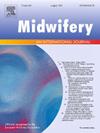Consolidation of the questionnaire proposed by National College of French Midwives to measure and characterise violence in perinatal care: Insights from women and representatives
IF 2.6
3区 医学
Q1 NURSING
引用次数: 0
Abstract
Background
Violence in perinatal care remains challenging to define, as well as to measure. To address this, a midwifery research group published a questionnaire endorsed by the French National College of Midwives, but women’s perspective was lacking.
Aim
To consolidate this questionnaire on violence in perinatal care with insights from women and their representatives.
Methods
We conducted a qualitative study, abiding by the COREQ criteria, based on semi-guided interviews held with 16 women and three representatives of perinatal patient organisations. Women were recruited via social media and targeted outreach. The interviews explored their understanding of the questionnaire, its relevance to their experiences, and potential areas for improvement. Data was transcribed and thematically analyzed.
Findings
Participants appreciated the questionnaire’s brevity and endorsed its use of the term ‘violence’, validating its focus on subjective experiences. However, they highlighted unclear items, such as assessing health professionals’ experience or evidence-based care. Suggested additions included categories of infantilizing language, as well as specific roles like radiologists and anesthetists. The nested aspect of the questionnaire was also discussed. Divergent opinions emerged regarding the timing of administration of the questionnaire, some favoring postpartum hospital stay and others suggesting later follow-up.
Discussion /Conclusion
This study highlighted the importance of including women to ensure the tool’s relevance and comprehensiveness. Revisions enhanced clarity, expanded the scope of professional interactions assessed, and introduced nuanced categories of violence. Challenges remain, including optimizing timing for questionnaire administration. Perspectives include dissemination within clinical practice, tests among minorities and validation of the questionnaire using psychometric tools.
整合法国助产士国家学院提出的调查问卷,以衡量和描述围产期护理中的暴力行为:来自妇女和代表的见解
围产期护理中的暴力仍然难以定义和衡量。为了解决这个问题,一个助产研究小组发布了一份由法国国家助产士学院认可的调查问卷,但缺乏女性的观点。目的将这份关于围产期护理中的暴力行为的问卷与妇女及其代表的见解结合起来。方法根据COREQ标准,对16名妇女和3名围产期患者组织代表进行半引导访谈,进行定性研究。女性是通过社交媒体和有针对性的外展招募的。访谈探讨了他们对问卷的理解,问卷与他们的经历的相关性,以及潜在的改进领域。对数据进行转录和主题分析。调查结果:参与者对问卷的简洁表示赞赏,并赞同其使用“暴力”一词,证实了其对主观体验的关注。然而,他们强调了不明确的项目,例如评估卫生专业人员的经验或基于证据的护理。建议增加的内容包括婴儿化语言类别,以及放射科医生和麻醉师等特定角色。本文还讨论了问卷的嵌套问题。关于问卷的使用时间出现了不同的意见,一些人赞成产后住院,另一些人建议以后随访。讨论/结论本研究强调了包括妇女以确保工具的相关性和全面性的重要性。修订提高了清晰度,扩大了评估的专业互动范围,并引入了细微差别的暴力类别。挑战依然存在,包括优化问卷管理的时机。观点包括临床实践中的传播,少数民族的测试和使用心理测量工具的问卷验证。
本文章由计算机程序翻译,如有差异,请以英文原文为准。
求助全文
约1分钟内获得全文
求助全文
来源期刊

Midwifery
医学-护理
CiteScore
4.50
自引率
7.40%
发文量
221
审稿时长
13.4 weeks
期刊介绍:
Midwifery publishes the latest peer reviewed international research to inform the safety, quality, outcomes and experiences of pregnancy, birth and maternity care for childbearing women, their babies and families. The journal’s publications support midwives and maternity care providers to explore and develop their knowledge, skills and attitudes informed by best available evidence.
Midwifery provides an international, interdisciplinary forum for the publication, dissemination and discussion of advances in evidence, controversies and current research, and promotes continuing education through publication of systematic and other scholarly reviews and updates. Midwifery articles cover the cultural, clinical, psycho-social, sociological, epidemiological, education, managerial, workforce, organizational and technological areas of practice in preconception, maternal and infant care.
The journal welcomes the highest quality scholarly research that employs rigorous methodology. Midwifery is a leading international journal in midwifery and maternal health with a current impact factor of 1.861 (© Thomson Reuters Journal Citation Reports 2016) and employs a double-blind peer review process.
 求助内容:
求助内容: 应助结果提醒方式:
应助结果提醒方式:


